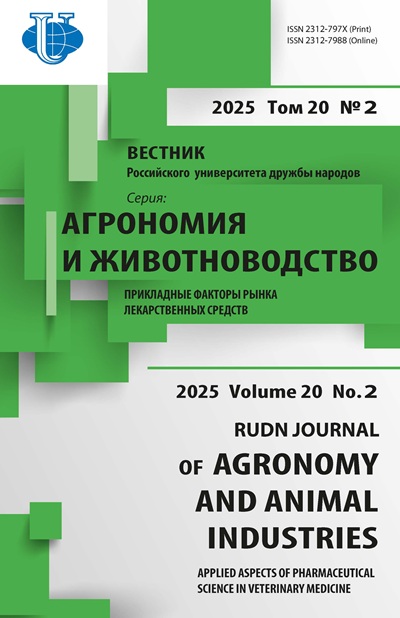ANALYSIS AND PREVENTION OF RISKS IN THE MANUFACTURE OF LABORATORY MICROBIOLOGICAL CULTURE MEDIA BY FMEA METHOD
- Authors: Nikitchenko V.E1, Rystsova E.O1, Chernysheva A.N1
-
Affiliations:
- Peoples’ Friendship University of Russia (RUDN University)
- Issue: Vol 14, No 1 (2019)
- Pages: 90-98
- Section: Veterinary sanitary inspection
- URL: https://agrojournal.rudn.ru/agronomy/article/view/19478
- DOI: https://doi.org/10.22363/2312-797X-2019-14-1-90-98
- ID: 19478
Cite item
Full Text
Abstract
At all stages of the production of microbiological nutrient media (MNM), the manufacturer, and in particular, the microbiological laboratories that manufacture the media on site, face many operational risks. The presence of such risks, in almost every critical point of production and further operation of the MNM, is due to the presence of common basic requirements for all MNM, which must be taken into account and respected during their development and preparation; as well as the complexity and laboriousness of the very process of manufacturing high-quality differential-diagnostic and other nutrient media, requiring the availability of all the components necessary for preparing these media, equipment, sterile conditions and qualified personnel. In this regard, there is a need to search for effective methods to identify and prevent undesirable situations associated with the production and use of MNM. The aim of this work was to adapt the risk assessment methodology based on the expert method for analyzing the types and consequences of FMEA failures (Failure Mode Effect Analysis) set out in GOST R ISO 31010-2011 for the needs of microbiological laboratories, including those for veterinary and sanitary expertise, producing microbiological nutrient environments and using them. As part of this work, a comparative analysis of risk assessment methods was carried out in order to select the optimal one; adaptation of the QMS principle - risk-oriented thinking and the FMEA method for risk assessment in the implementation of MNM manufacturing processes in a microbiological laboratory (for example, solid agar media); risk assessment protocol forms were developed; calculations of a quantitative assessment of risk levels were carried out in order to determine the need for preventive actions and their implementation in order to minimize the negative consequences of risk in case of its implementation using the developed protocols. The results showed that this technique can be successfully implemented and used in the claimed area.
About the authors
Vladimir E Nikitchenko
Peoples’ Friendship University of Russia (RUDN University)
Author for correspondence.
Email: v.e.nikitchenko@mail.ru
-
6 Miklukho-Maklaya Street, Moscow, 117198, Russian FederationEkaterina O Rystsova
Peoples’ Friendship University of Russia (RUDN University)
Email: ekaterina-ryscova@yandex.ru
-
6 Miklukho-Maklaya Street, Moscow, 117198, Russian FederationAnastasiya N Chernysheva
Peoples’ Friendship University of Russia (RUDN University)
Email: a69117@yandex.ru
-
6 Miklukho-Maklaya Street, Moscow, 117198, Russian FederationReferences
- OJSC “All-Russian Scientific Research Institute of Certification”. GOST ISO 9001: 2015 (GOST R ISO 9001-2015). Quality Management Systems. Moscow: Standardinform Publ.; 2018. Available from: http://docs.cntd.ru/document/1200124394 [Accessed 27th May 2018]. (In Russ).
- Galynkin VA, Zaikina NA, Kocherovets V.I. Nutrient media for microbiological quality control of drugs and food. St. Petersburg: Prospekt Nauki Publ.; 2006. (In Russ).
- International Organization for Standardization. ISO 22000:2018. Food Safety Management System. Requirements for all organizations in the chain of production and consumption of food. 2018. (In Russ).
- Laboratory of problems of clinical and laboratory diagnostics of the Moscow Medical Academy named after IM Sechenov. GOST R EN 12322-2010 Medical devices for in vitro diagnostics. Nutrient media for microbiology. Criteria of functional characteristics of nutrient media. Moscow: Standardinform Publ.; 2011. Available from: http://docs.cntd.ru/document/1200082586 [Accessed 27th May 2018]. (In Russ).
- Autonomous non-commercial organization “Research Center for Monitoring and Diagnostics of Technical Systems”. GOST R ISO/IEC 31010-2011. Risk management. Risk assessment methods. Moscow: Standardinform Publ; 2012. Available from: http://docs.cntd.ru/document/ 1200090083 [Accessed 29th May 2018]. (In Russ).
- Nice management. Project Risk Management. Available from: http://www.nicemanagement.ru/ doips-665-2.html [Accessed 30th May 2018]. (In Russ).
- OJSC “Research Center for Monitoring and Diagnostics of Technical Systems”. GOST R 51901.12-2007 (IEC 60812: 2006) Risk management. Method of analyzing the types and consequences of failures. Moscow: Standardinform Publ.; 2008. Available from: http://docs.cntd.ru/ document/1200062125 [Accessed 29th May 2018]. (In Russ).
- Federal Hygiene and Epidemiology Centre, Determination of coliform bacteria and E. coli using chromogenic and fluorogenic indicator media produced by Merck (Germany): Guidelines [24 FC/3947]. 2004. Available from: http://docs.cntd.ru/document/1200092737 [Accessed 27th May 2018]. (In Russ).
- Prozorkina HV, Rubashkina PA. Basics of Microbiology, Virology and Immunology: A textbook for secondary special medical schools. Rostov-on-Don: Feniks; 2002. (In Russ).
- Egorova IY, Nikitchenko VE, Nikitchenko DV, Chernysheva AN, Rystsova EO. Microbiological nutrient media the new format in the veterinary-sanitary assessment food and raw materials of animal origin. RUDN Journal of Agronomy and Animal Industries. 2017; 12(1): 76—85. Available from: doi: 10.22363/2312-797X-2017-12-1-76-85 (In Russ).
- Shuliak TL. Basics of scientific research: teaching aid for students of the specialty 1-49 01 02 “Technology of storage and processing of animal raw materials” specialization 1-49 01 02 02 “Technology of milk and dairy products”. Mogilyov: UO MGUP Publ.; 2009. (In Russ).
Supplementary files















